REINVENTING THE COUPÉ – XJ40 V12 Coupé – M690 CRW
Reproduced with permission of Classic Jaguar magazine (April – May 2020)
CARS FROM THE COLLECTION – PART FIVE
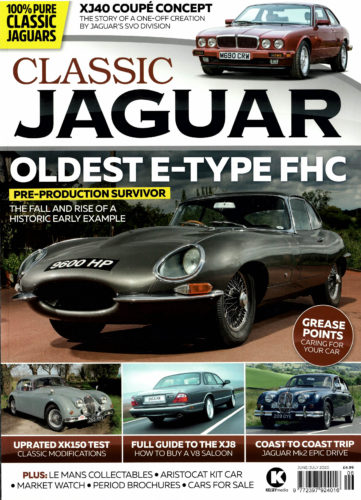
Classic Jaguar
June-July 2020
Late in the career of the XJ40, Jaguar’s Special Vehicle Operations set about creating a one-off coupé concept – a car that aimed to emulate the classic XJ-C, albeit with a modern twist.
As we revealed in the last issue of Classic Jaguar magazine, Ford’s acquisition of our favourite marque thirty years ago brought with it many challenges. The American giant had paid a vast sum for a company with essentially a two-model line-up, which made expansion of the Jaguar range one of Ford’s main priorities. Equally important, however, was the need to keep its existing range competitive, particularly the ageing XJ-S – a model that would see major updates during its final few years on sale, resulting in an impressive uplift in sales. A question mark remained, however, over how Ford would treat the XJ40.
By Jaguar standards, the company’s latest saloon was still in its infancy, having been launched back in 1986. Nevertheless, Ford embarked upon a replacement programme at the earliest opportunity, resulting in the launch of the X300-generation XJ range by 1994 – a line-up that marked the return of a more traditional Jaguar look. Until the arrival of the X300, however, the XJ40 received numerous updates under Ford ownership, the first of which arrived during the same year that the Blue Oval officially took charge.
By 1990, for example, the latest 4.0 litre version of the XJ40’s AJ6 engine offered 235 bhp compared with the 221 bhp of its 3.6 predecessor while the 3.2 of 1991 gave 220 bhp – a big improvement on the 165 bhp of the 2.9 that had gone before. The arrival of the XJ12 for 1993 obviously gave the XJ40 range a major boost, while the debut of XJ6 3.2S and 4.0S models during the same year added a sporty twist to the line-up. As for those seeking the ultimate in prestige, the announcement of the extended-wheelbase Daimler Majestic (which also arrived in 1993) meant that the company had an effective replacement for the old Daimler Limousine.
MODERN APPROACH
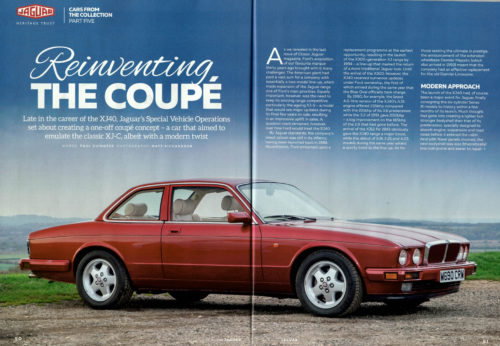
Classic Jaguar – June July 2020
Reinventing The Coupé
M690 CRW Pages 50-51
The launch of the XJ40 had, of course, been a major event for Jaguar, finally consigning the six-cylinder Series III models to history within a few months of its launch. Much thought had gone into creating a lighter but stronger bodyshell than that of its predecessor, specially designed to absorb engine, suspension and road noise before it entered the cabin. And with fewer panels involved, the new bodyshell was also (theoretically) less rust-prone and easier to repair.
Equally impressive had been Jaguar’s new-design independent rear suspension, conceived by engineering boss Jim Randle. The driveshaft doubled as an upper link, while the lower link’s inner mounting was designed for fore-and-aft movement to dramatically improve ride quality over potholes and bumps. With combined coil spring and damper units also used, the XJ40 offered a superb combination of handling prowess and sumptuous ride quality.
As a sophisticated and good-value rival to the increasingly dominant luxury cars from Germany, the XJ40 did Jaguar proud. It survived for eight years before being killed off in order to make way for the aforementioned X300 line-up. Having attracted more than 208,000 buyers during its successful run, the XJ40 had more than lived up to expectations, with its various mid-life revisions helping it to remain competitive throughout the early ’90s. Not every XJ40-based proposal managed to make it to market, however, which explains why the coupé concept shown here remains a strict one-off – as well as a fascinating insight into Jaguar’s Special Vehicle Operations (SVO) thinking of the time.
TWO-DOOR SPECIAL
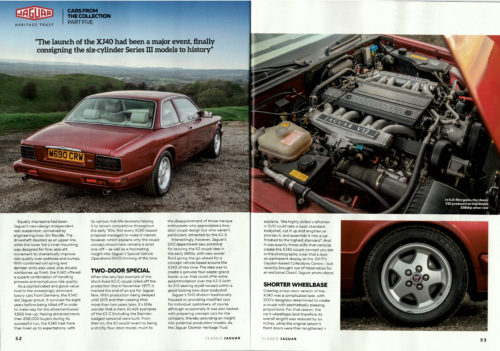
Classic Jaguar – June July 2020
Reinventing The Coupé
M690 CRW Pages 52-53
When the very last example of the short-lived XJ-C coupé rolled off the production line in November 1977, it marked the end of an era for Jaguar Fans. With production being delayed until 1975 and then ceasing little more than two years later, it’s little wonder that a mere 10,426 examples of the XJ-C (including the Daimler-badged versions) were built. From then on, the XJ would revert to being a strictly four-door model, much to the disappointment of those marque enthusiasts who appreciated a two-door coupé design but who weren’t particularly attracted by the XJ-S.
Interestingly, however, Jaguar’s SVO department saw potential for reviving the XJ coupé idea in the early 1990s, with new owner Ford giving the go-ahead around the XJ40 of the time. The idea was to create a genuine four-seater grand tourer, a car that could offer extra accommodation over the XJ-S (with its 2+2 seating style) housed within a good looking two-door bodyshell.
Jaguar’s SVO division traditionally focused on providing modified cars for individual customers, of course, although occasionally it was also tasked with preparing concept cars for the company, thereby providing an insight into potential production models. As the Jaguar Daimler Heritage Trust explains, “the highly skilled craftsmen in SVO could take a basic standard bodyshell, cut it up and lengthen or shorten it, and assemble it into a car finished to the highest standard”. And it was exactly these skills that came to create the XJ40 coupé concept you see in the photographs, a car that’s now on permanent display at the JDHT’s Gaydon-based Collections Centre – but recently brought out of hibernation for an exclusive Classic Jaguar photo shoot.
SHORTER WHEELBASE
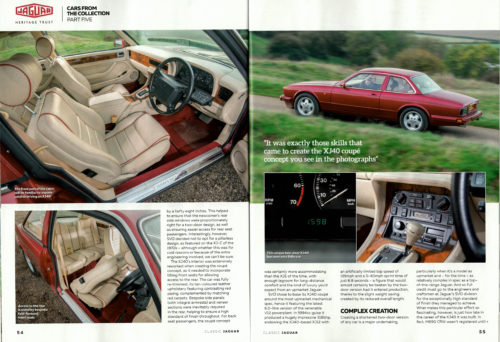
Classic Jaguar – June July 2020
Reinventing The Coupé
M690 CRW Pages 54-55
Creating a two-door version of the XJ40 was a complicated task, with SVO’s designers determined to create a coupé with aesthetically pleasing proportions. For that reason, the car’s wheelbase (and therefore its overall length) was reduced by six inches, while the original saloon’s front doors were then lengthened by a hefty eight inches. This helped to ensure that the newcomer’s rear side windows were proportionately right for two-door design, as well as ensuring easier access for rear seat passengers. Interestingly, however, SVO decided not to opt for a pillarless design, as featured on the XJ-C of the 1970s – although whether this was for cost reasons or because of the extra engineering involved, we can’t be sure.
The XJ40’s interior was extensively reworked when creating the coupé concept, as it needed to incorporate tilting front seats for allowing access to the rear. The car was fully re-trimmed, its tan-coloured leather upholstery featuring contrasting red piping, complemented by matching red carpets. Bespoke side panels (with integral armrests) and veneer sections were inevitably required in the rear, helping to ensure a high standard of finish throughout. For back seat passengers, the coupé concept was certainly more accommodating than the XJS of the time, with enough legroom for long-distance comfort and the kind of luxury you’d expect from an upmarket Jaguar.
SVO chose to base its XJ40 coupé around the most upmarket mechanical spec, hence it featuring the latest 6.0 litre version of the venerable V12 powerplant. In 5,994 cc guise it produced a hugely impressive 318 bhp, endowing the XJ40-based XJ12 with an artificially limited top speed of 155 mph and a 0-60 mph sprint time of just 6.8 seconds – a figure that would almost certainly be beaten by a two-door version had it entered production, thanks to the slight weight saving created by its reduced overall length.
COMPLEX CREATION
Creating a shortened two-door version of any car is a major undertaking, particularly when it’s a model as upmarket and – for the time – as relatively complex in spec as a top-of-the-range Jaguar. and so full credit must go to the engineers and craftsmen at Jaguar’s SVO division for the exceptionally high standard of finish they managed to achieve. What makes this particular effort so fascinating, however, is just how late in the career of the XJ40 it was built. In fact, M690 CRW wasn’t registered until August 1994, just a couple of months before the X300’s debut at the Paris Motor Show – and as the JDHT readily admits, this meant it “would not have been introduced in the form seen here”. Any production version would have been based around the X300, which was essentially a reskinned version of its predecessor – although, of course, Ford-owned Jaguar had other priorities.
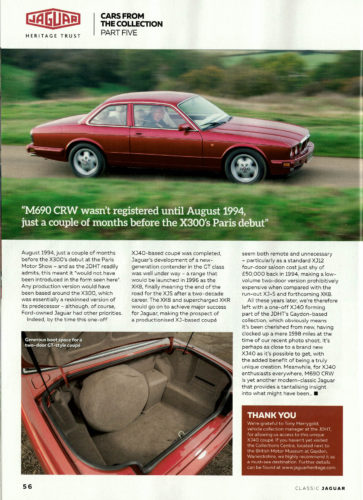
Classic Jaguar
June July 2020
Reinventing The Coupé
M690 CRW Page 56
Indeed, by the time this one-off XJ40-based coupé was completed, Jaguar’s development of a new-generation contender in the GT class was well under way – a range that would be launched in 1996 as the XK8, finally meaning the end of the road for the XJS after a two-decade career. The XK8 and supercharged XKR would go on to achieve major success for Jaguar, making the prospect of a productionised XJ-based coupé seem both remote and unnecessary – particularly as a standard XJ12 four-door saloon cost just shy of £50,000 back in 1994, making a low-volume two-door version prohibitively expensive when compared with the run-out XJ-S and forthcoming XK8.
All these years later, we’re therefore left with a one-off XJ40 forming part of the JDHT’s Gaydon-based collection, which obviously means it’s been cherished from new, having clocked up a mere 1,598 miles at the time of our recent photo shoot. It’s perhaps as close to a brand new XJ40 as it’s possible of being a truly unique creation. Meanwhile, for the XJ40 enthusiasts everywhere, M690 CRW is yet another modern-classic Jaguar that provides a tantalising insight into what might have been..
THANK YOU
We’re grateful to Tony Merrygold, the vehicle collection manager at the JDHT, for allowing us access to this unique XJ40 coupé. If you haven’t yet visited the Collections Centre, located next to the British Motor Museum at Gaydon, Warwickshire, we highly recommend it as a must-see destination. Further details can be found at www.jaguarheritage.com.
Words: Paul Guinness
Photography: Matt Richardson